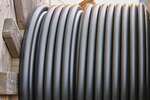News Release from windfair.net
Wind Industry Profile of
TenneT’s half-year figures show good progress and continued high security of supply
In the first six months of 2016, TenneT has succeeded in maintaining the security of electricity supply at an exceptionally high level of 99.999%, and has made further progress in integrating the North-West European electricity markets. These core activities were complemented by a solid financial performance. Regretfully an employee from Liandon, one of TenneT's contractors, was fatally injured in a work accident that occurred in February 2016.
Energy transition
The energy transition is in full swing, not only in Germany but also in the Netherlands. Earlier this year, the Dutch Senate provided the required legal basis for the development of offshore wind energy in the Dutch part of the North Sea. Subsequently, the Dutch regulator (ACM) certified TenneT as offshore grid operator in July. As a result, the Dutch minister of economic affairs can now officially appoint TenneT as developer and operator of offshore grid connections in the Dutch part of the North Sea. In June, TenneT presented its vision for further integration and collaboration among the countries bordering the North Sea with a view to achieving medium- to long-term sustainability targets. The development of an artificial island in the middle of the North Sea that can serve as a ‘hub and spoke’ for a European sustainable energy supply system is central to TenneT’s North Sea Infrastructure concept.
TenneT CEO Mel Kroon commented: “In this part of Europe the energy transition means the availability and demand of renewables has to be connected over big distances which requires infrastructure. In addition, further North West European integration and collaboration on the energy transition is essential if we want to continue achieving societal sustainability targets in the future.”
Financial results
In the first half of 2016, TenneT continued to invest heavily in reinforcing the electricity infrastructure in the Netherlands and Germany in order to maintain the existing high level of security of supply and to integrate renewable energy sources into the grid. Investments in tangible fixed assets totalled EUR 875 million in the first six months of 2016.
Key underlying1 financial results
| (Figures in millions of euros) | 30 June 2016 | 30 June 2015 |
|---|---|---|
| Revenue | 1,546 | 1,395 |
| EBIT | 414 | 490 |
| Investments in tangible fixed assets | 875 | 1,196 |
| (Figures in millions of euros) | 30 June 2016 | 30 June 2015 |
|---|---|---|
| Total assets | 16,881 | 15,424 |
| Net interest-bearing debt, adjusted | 6,682 | 5,703 |
| Equity | 3,736 | 3,803 |
Underlying revenue rose from EUR 1,395 million in the first half of 2015 to EUR 1,546 million in the first six months of this year. This increase is attributable to the growth in TenneT's asset base and compensation of the increased costs of system services. Underlying EBIT decreased from EUR 490 million at 30 June 2015 to EUR 414 million at 30 June 2016, mainly due to the impact of special items which were higher in 2015. Among others this related to the release of offshore liability provisions and an incidental gain on the sale of APX shares in 2015. The underlying result for the first half of 2016 was negatively impacted by a change of discount factor applied to German pension provisions, which will be settled in future tariffs.
The regulatory authorities in the Netherlands (Authority for Consumers & Markets, ACM) and Germany (Bundesnetzagentur, BNetzA) both announced plans to reduce the permitted (‘regulatory’) rate of return. The regulatory rate of return on equity capital is proposed to be decreased from 5.6% to 4.9% (after tax) in the Netherlands, and from 9,05 % (7.4% after tax) to 6,91 % (5.6% after tax) in Germany. Final decisions are expected this fall.
TenneT CFO Otto Jager commented: “The operating performance we have realized is in line with our total investments and supports our debt portfolio, which currently amounts to EUR 5.8 billion. However, a stable regulatory regime is essential in order to continue obtaining financing to support our extensive investment agenda.”
Financing
In June 2016, TenneT issued EUR 1 billion in so-called ‘green bonds’ for investments in the transmission of renewable electricity from offshore wind farms to the onshore electricity grid. In May 2016, TenneT also issued EUR 500 million in ‘green loans’ in Germany. The issue of green bonds and loans demonstrates TenneT’s commitment to working with stakeholders to continually improve and innovate in efforts to realize a more sustainable energy future. As the first Dutch corporate issuer of green bonds, TenneT today will open the trading day on the Euronext stock exchange in Amsterdam.
Earlier this month, the Dutch State announced its intention to make an additional equity contribution of up to EUR 1.2 billion over the years 2017-2020 for financing of required investments in the Dutch electricity grid.
TenneT's senior unsecured credit ratings remain unchanged in the first half of 2016:
| Long-term rating | Short-term rating | |
|---|---|---|
| Standard & Poor’s | A- (stable outlook) | A-2 |
| Moody’s | A3 (stable outlook) | P-2 |
Progress on onshore grid expansion projects in the Netherlands
In the Netherlands the construction of a number of large high-voltage infrastructure projects is going according to plan. TenneT has started work on the construction of a fourth cross-border electricity connection (interconnector) from Doetinchem in the Netherlands to the German town of Wesel. The construction of the so-called North Ring of the Randstad 380 kV connection (serving the northern section of the Randstad conurbation) is also proceeding apace. In both the North and South-West of the Netherlands, TenneT and the Dutch Ministry of Economic Affairs are consulting closely with local and regional stakeholders about the expansion and upgrading of the electricity grid.
DC connections and underground cables in German onshore grid projects
TenneT has been officially designated to construct the SuedOstLink connection between the federal states of Saxony-Anhalt and Bavaria. This will be the second largest direct-current (DC) onshore electricity connection in Germany, after the SuedLink connection. In January 2016, the German parliament adopted a law that prioritizes the underground installation of DC cables. This means that the routes of DC connections will be redesigned at many locations to make underground installation possible. The long distances of the German onshore grid connections, the substantial number of stakeholders as well as technical, permitting and licensing complexity make these projects challenging and costly.
Offshore developments
In March 2016 the Dutch Senate approved the amended Electricity Act, which formalizes TenneT’s role as the developer and operator of the offshore electricity grid. In the coming years TenneT will build five identical offshore platforms with a total capacity of 3,500 MW (powering 3.5 million households with green electricity in the Dutch sector of the North Sea in order to transport wind energy to the onshore grid. In Germany, TenneT is working on the DolWin3, BorWin3 and Nordergründe offshore grid connections, which have a joint capacity of 2,827 MW. These projects will increase the total wind energy capacity connected to the German grid to 7,132 MW by 2019.
TenneT has also started preparations for the construction of NordLink, the first high-capacity electricity cable (1,400 MW) between Norway and Germany. NordLink will complement TenneT’s existing subsea power cables with Norway and with the United Kingdom, as well as the three existing onshore high-voltage connections between the Netherlands and Germany (with a fourth one under construction). In the autumn of 2016 TenneT will start work on the COBRACable, a new 700 MW interconnector that will connect the Dutch and Danish electricity grids.
- Source:
- TenneT
- Link:
- www.tennet.eu/...
- Keywords:
- TenneT, Netherlands, Germany, Offshore, Grid








